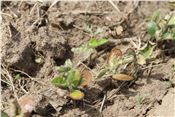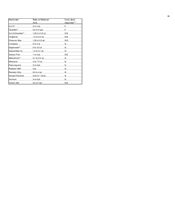Early Season Soybean Injury Does Not Always Translate Into Yield Loss
DR. MANDY BISH AND KEVIN BRADLEY
COLUMBIA, MO.
Last year, we had more soybean injury from pre-emergence herbicides than I’ve ever seen. It was an epidemic that many farmers across the state experienced, brought on mostly by the prolonged periods of cool and wet weather before and after planting. This year, there are already some calls and samples that have started to come in with these same issues. I don’t know if we’re going to see as much soybean injury as last year or not (I hope not), but I do think that if we are going to continue to have resistant waterhemp as our number one weed problem, our growers are going to have to get used to seeing some degree of early season soybean injury. And the good news is, early season injury as a result of pre-emergence herbicides doesn’t always translate into soybean yield loss. Of course whether or not you have yield loss will depend on a lot of factors, most notably the growing conditions after herbicide application, but we conducted one study last year that has helped us understand this issue a little better. In this study, we measured soybean height and biomass reduction in response to pre-emergence soybean herbicides 5 weeks after emergence and then followed this through to see what impact these injury levels had on yield at the end of the season. A small portion of the results from the study are shown in the graph below (to see all of the results go to (http://weedscience.missouri.edu/weedtrials/graphs/PPO%20and%20ALS.pdf ).
Basically, what this one year of data would suggest is that soybean plants can recover from a substantial amount of early season injury and, as mentioned above, that early season injury doesn’t always translate into soybean yield loss. As shown in the graph below, we measured as much as 23% soybean height reduction and 28% biomass reduction in response to these pretty standard Authority XL and Authority Maxx herbicide treatments, but neither resulted in any statistically significant yield loss when compared to the weed-free, non-treated control. I think these results can be used as a guide for what we could experience in the next several weeks--we may see some pretty substantial injury that looks significant, but just wait for the soybean to get some better growing conditions and grow through it and chances are you will be much better off to keep the original stand than to tear it all up and start over. We have a new student that is beginning his research this season and will be tackling this issue for the next several years. We hope to be able to provide more results about how early season soybean injury correlates with yield loss in the future.
Grazing and mowing can help reduce populations of curly dock. However, the weed has been shown to be toxic when consumed in large amounts. Curly dock seedlings can be controlled effectively with spring herbicide applications. However once the weed becomes established, fall applications may prove more effective.
For selective control of curly dock in grass pastures and hayfields, metsulfuron products (Cimarron, Cimarron Max, Chaparral, etc.), 2,4-D and dicamba combinations (Weedmaster, etc.), or combinations of GrazonNext or Grazon P+D with triplopyr (Remedy, PastureGard, etc.) are effective foliar sprays (Table 1).
In established legumes such as alfalfa, curly dock is one of the most common and problematic weed species. Few chemical treatment options exist for control of curly dock in non-Roundup Ready alfalfa stands. Researchers at Penn State have found that Gramoxone Inteon can be applied at 2 to 3 pt/A to established, dormant alfalfa stands in the spring PRIOR TO 2 INCHES OF REGROWTH. Raptor can be applied at a rate of 4 to 6 fl oz/A on seedlings or established alfalfa stands if application is made prior to significant alfalfa growth or regrowth to 3 inches. Pursuit is labeled at a rate of 1.08 to 2.16 oz/A for use in established alfalfa and alfalfa-grass mixtures and can be effective when applied on curly dock seedlings. Glyphosate is an effective foliar spot-spray option; however, it is non-selective and will injure any portion of the crop that it contacts.
Curly dock can also become a problem weed of no-till corn or soybean systems and must be dealt with prior to planting in the spring. While it is difficult to achieve complete control of the rootstocks with any treatment, there are a number of herbicide combinations that will provide adequate desiccation of the above-ground foliage such that this weed will not be a problem in the subsequent corn or soybean crop. Higher rates of glyphosate in combination with 2,4-D or dicamba will provide good control of curly dock, but keep in mind the plant back restrictions that are required after application of 2,4-D and dicamba. Paraquat (Gramoxone) plus 2,4-D or dicamba can also provide acceptable control of curly dock prior to planting, but as mentioned previously plants will likely re-emerge from the stout taproots in the following year. ∆
DR. MANDY BISH: Division of Plant Sciences, University of Missouri
DR. KEVIN BRADLEY: Associate Professor, Division of Plant Sciences, University of Missouri

Figure 1: Early season soybean injury like this is pretty typical of what you can see from soil-applied group 14 (PPO) herbicides like flumioxazin and sulfentrazone. This often occurs under cool, wet conditions when soybean plants aren’t able to metabolize the herbicide(s) as rapidly as usual.

Table 1: Curly dock response to herbicides for grass pastures****

*See herbicide labels for grazing and foraging restrictions
**A variety of trade names exist.
***Key:
E = Excellent, >90% control
G = Good, 80 to 90% control
F = Fair, 60 to 80% control
P = Poor, <60% control
****Data taken from the 2015 University of Missouri Extension Publication IPM1031 “Weed and Brush Control For Forages, Pastures, and Non-cropland”
To see more images of curly dock, visit weedid.missouri.edu.
To learn more about weed and brush control in pasture and non-crop settings, purchase a copy of extension publication IPM1031 at: http://extension.missouri.edu/p/ipm1031
1Mack RN and M Erneberg (2002) The United States Naturalized Flora: Largely the Product of Deliberate Introductions. Annals of the Missouri Botanical Garden 89(2): 176-189.
2Hujerova R, Pavlu V, Hejcman M, Pavlu L, and J Gaisler (2013) Effect of cutting frequency on above- and below-grownd biomass production of Rumex alpinus, R. cripsus, R. obtusifolius, and the Rumex hybrid (R. patient x R. tianschanicus) in the seeding year. Weed Research 53:378-386.
3Kivilaan A and RS Bandurski (1973) The Ninety-Year Period for Dr. Beal’s Seed Viability Experiment. American Journal of Botany 60(2): 140-145.
Revised: May 19, 2015 University of Missouri